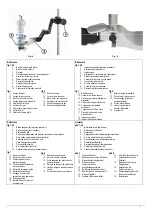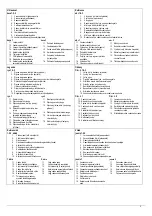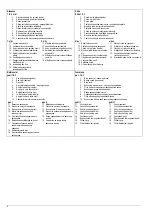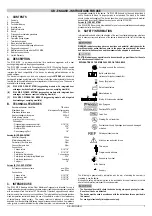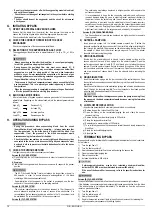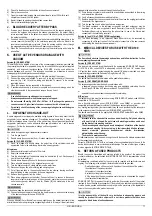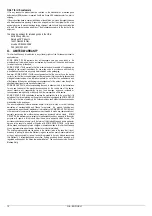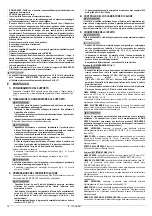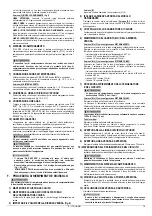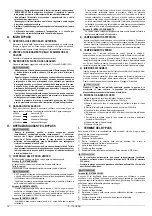
8
GB - ENGLISH
- SORIN GROUP ITALIA is not responsible for problems arising from inexperience
or improper use.
- FRAGILE, handle with care.
- Keep dry. Store at room temperature.
- Always apply and maintain a
correct dose and accurate monitoring of the
anticoagulant before, during and after the bypass.
- For single use and for single-patient use only. During use the device is in
contact with human blood, body fluids, liquids or gases for the purpose of
eventual infusion, administration or introduction into the body, and due to its
specific design it cannot be fully cleaned and disinfected after use. Therefore,
reuse on other patients might cause cross-contamination, infection and sepsis.
In addition, the reuse increases the probability of product failure (integrity,
functionality and clinical effectiveness).
- The device must not undergo any further processing.
- Do not resterilize.
- After use, dispose of the device in accordance with applicable regulations in
force in the country of use.
- The device must only be used if STERILE.
- The device contains phthalates. Considering the nature of contact with the body,
the limited duration of contact and the number of treatments per patient, the
amount of phthalates which might be released from the device does not raise
specific concerns about residual risks. Further information is available on
request from Sorin Group Italia
- For further information and/or in case of complaint contact SORIN GROUP
ITALIA or the authorised local representative.
- Federal law (U.S.A.) restricts this device to sale by or on the order of
a
physician.
- Inner surfaces of the system are Ph.I.S.I.O. coated, currently SORIN GROUP
ITALIA is not aware of any contraindication to the use of systems having
components treated with Ph.I.S.I.O.
E. SET-UP
1) POSITION THE HOLDER
Position the D633 holder on the pump structure by means of the clamp at the
upper end of the arm (fig. 4, ref. 1).
2) FIX THE OXYGENATOR TO THE HOLDER
- Do not use if sterile packaging is damaged, unsealed, or has been
exposed to moisture or other conditions that would compromise the
sterility of the device.
- Check the expiry date on the label attached. Do not use the device after the
date shown.
- The device must be used immediately after opening the sterile
packaging.
- The device must be handled aseptically.
Remove the device from the sterile packaging.
- Carry out a
visual inspection and carefully check the device before use.
Transportation and/or storage conditions other than those prescribed may
have caused damage to the device.
- Check and tighten all luer lock connections.
- Do not use solvents such as alcohol, ether, acetone, etc.: as contact may
cause damage to the device.
- Do not allow halogenated liquids such as Halothane and Fluothane to
come into contact with the polycarbonate housing of the device. This
could cause damage which may compromise the integrity and proper
functioning of the device.
Attach the device to the holder:
-
Position the locking mechanism of the holder (fig. 4, ref. 3) on “OPEN” position.
-
Insert the device into the locking clamp of the holder (fig 4, ref. 2)
Carry out a
visual inspection and carefully check to have the device
properly placed into the locking clamp of the holder (fig. 5).
-
Position the locking mechanism of the holder in “CLOSED” position (fig. 4, ref. 3).
3) HEATER-COOLER SET-UP
Connect the water lines to the Kids D100 water connectors by means of the
female Hansen connectors (SORIN GROUP code 09028 or equivalent).
- The use of different connectors from those indicated may cause
resistance inside the water circuit and reduce the efficiency of the heat
exchanger.
- Do not obstruct the hole on the heat exchanger lower cover (fig 1-2-3, ref.
8) as it is the outlet of the heat exchanger safety channel.
- The water temperature at the heat exchanger inlet must not exceed 42
C
(108
F).
- The water pressure in the heat exchanger must not exceed 1500 mmHg
(200 Kpa / 2 bar / 29 psi).
4) CHECK THE HEAT EXCHANGER
Check the heat exchanger by circulating water inside the heat exchanger for
a
few minutes. There should be no leaks from the water compartment or
from the safety channel hole (fig 1-2-3, ref. 8). In case of leaks discard the
unit.
5) CIRCUIT CONNECTIONS
All connections downstream of the pump must be secured by means of
safety ties.
- If oxygenated blood is necessary for blood cardioplegia, connect a
3 way
stopcock (not supplied with the device) to luer connection positioned on
the arterial sampling line (fig. 1-2-3, ref. 9). The third stopcock way will
supply oxygenated blood.
- As alternative to the stopcock, the arterial temperature probe site (fig.1-2-
3 ref.5) can be unscrewed and the blood cardioplegia line connected onto
this access port.
- Never infuse or introduce fluids through any connector on the arterial line.
Version [A], OPEN SYSTEM (fig 1)
- The special positive and negative pressure relief valve is mounted on the
lid of the venous reservoir. It starts to release positive pressures at +5
mmHg (0.7 kPa/ 0.007
bar/ 0.1 psi) and negative pressures at -80 mmHg (-
10.4 kPa / -0.10 bar /
-1,53
psi). The action of the valve by itself does not prevent from the over /
under pressurization of the reservoir in all operating conditions.
- Do not for any reason occlude the external access hole of pressure relief
valve. Remove tab inserted in pressure relief valve (ref. 17) from the valve
prior to use.
VENOUS LINE:
remove the protective cap and
connect a
venous line of either 3/16”
or 1/4“ to the connector indicated on the venous reservoir as “VENOUS RETURN”
(ref. 12).
The Venous Return connector can be rotated 360
to find the most convenient
position of the venous line.
CARDIOTOMY SUCTION LINES:
after removing protective caps from the
“filtered” inlet connectors located on top of the Venous Reservoir (7 x Luer-Locks
inlets) connect the extremities of the suction lines.
Cardiotomy suction lines must always be connected by using Male
LuerLock Adaptor Kits separately provided by SORIN GROUP. Male luers
not supplied with SORIN GROUP products may damage the female luer-
locks at the top of the reservoir and may not be correctly secured.
ARTERIAL LINE:
remove the red cap from the oxygenator arterial outlet indicated
as “ARTERIAL OUTLET” (ref. 2) and connect a
3/16” line.
PUMP LINE:
the pump loop should be connected between the venous reservoir
outlet connector (ref. 13) and the oxygenator venous inlet connector (ref. 1)
always paying attention to the direction of rotation of the main pump.
RESERVOIR VENT:
Remove yellow cap from the reservoir vent connector (ref.
16).
Version [B], CLOSED SYSTEM (fig 2)
VENOUS LINE:
it is possible to connect a
venous line of 3/16” or 1/4“ to the
connector indicated on the venous reservoir as “VENOUS RETURN” (ref. 12).
CARDIOTOMY LINE:
it is possible to connect the 1/4" or 3/16" cardiotomy line to
the soft venous reservoir connector indicated as “CARDIOTOMY RETURN” (ref.
14).
The line connecting the cardiotomy to the venous reservoir must form a
U-shaped
trap extending at least 5 cm below the venous reservoir, such that the U prevents
air entering the venous reservoir from the cardiotomy.
The cardiotomy shall be easily raised or lowered to allow for variations in
haemodynamic state.
ARTERIAL LINE:
remove the red cap on the oxygenator arterial outlet (ref. 2) in
order to connect a
3/16" line.
PUMP LINE:
the pump loop should be connected between the venous reservoir
outlet connector (ref. 13) and the oxygenator venous inlet connector (ref. 1)
always paying attentionto the direction of rotation of the main pump.
VENOUS RESERVOIR PURGE LINE:
remove the protective cap and connect the
male luer end of the soft venous reservoir purge line (ref. 15) to a
female luer located
on a
suction line (this connection must be made on the "negative pressure" side of
the line).
Содержание KIDS D100
Страница 2: ...2 Fig 1 Fig 3 Fig 2 ...



